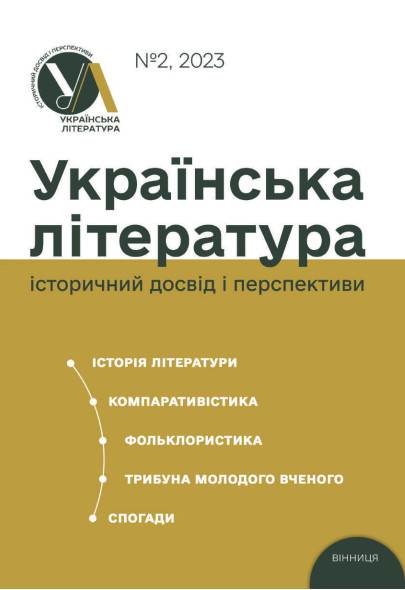«У місці світлому, у місці квітучому, у місці спокійному»: Locus amoenus у малій прозі Василя Симоненка (на матеріалі новели «Вино з троянд»)
https://doi.org/10.31652/3041-1084-2023-2-27-38Опубліковано 2023-11-15
Ключові слова
- новела, locus amoenus, екзистенційна комунікація, символи, сад, квітник
Авторське право (c) 2024 Ольга Деркачова

Ця робота ліцензується відповідно до ліцензії Creative Commons Attribution 4.0 International License.
Як цитувати
Анотація
The article deals with the short story from Vasyl Symonenko’s book of prose «Vyno z Troyand (The Rose Wine)» and considers the characteristics of the presence of locus amoenus in this text. One of the special features of the texts of this book is the search for quietness and peace by the heroes: in a sincere conversation, in a favorite activity, in childhood memories, in being with nature. The most interesting in this aspect is the short story «Vyno z Troyand (The Rose Wine)», which combines the Christian and romantic fairy-tale tradition of depicting the meeting place of lovers, which becomes the locus amoenus. Locus amoenus, known since ancient and medieval literature, is interpreted as a place of well-being, which often appears in writings as a beautiful and cozy place with flowers, trees, and a pond where lovers meet. This place appears in the short story as an image of a garden tended by one of the main characters. And this is its greatest value, because it is not gifted by someone or found by chance, but created by the careful hands of a gardener after his experience of the heavy loss. The place of well-being is interpreted through the biblical tradition of the image of the Garden of Eden, the garden in Solomon’s «Song of Songs», as well as through the tradition of the image of the garden and flower gardens in the Christian fairy tales of Hans Christian Andersen. In the first case, it is a return to the lost garden of paradise, in the second case, it is the discovery of such a garden for oneself and a loved one, in the third case, it is a search for a heavenly corner on earth, meeting and talking with flowers, searching among them for the souls of those who found peace in the quiet and blooming place. In Vasyl Symonenko’s short story, a blooming garden created by Andriy’s hands is like a corner of heaven on earth. He began to grow and care for it after the death of his mother and gladly gave its fruits, and not only fruits, but also fairy tales about flowers. In the same garden, he is waiting for Olha, the conversation with whom becomes the beginning of something special and important. Through the interpretation of the locus amoenus, it is concluded that spirituality and the soul are the main in the worldview of the heroes of this short story, while external beauty is a conditional and not important. The garden in the novel is a place where heroes can be real and truly free from the stamp of a Soviet man.
Завантаження
Посилання
- Андерсен Г. К. Казки. https://e-bookua.org.ua/dyt/475-andersen-g-k-kazki-zbrka.html#google_vignette
- Балла Е. Наративний дискурс малої прози Василя Симоненка. Сучасні проблеми мовознавства та літературознавства : зб. наук. праць / відп. ред. І. В. Сабадош. Ужгород, 2014. Вип. 19. С. 132–137. http://nbuv.gov.ua/UJRN/spml_2014_19_24
- Бакіна Т. Флористичні образи в казках та історіях Г.-Х. Андерсена. Національна ідентичність в мові і культурі : збірник наукових праць. За заг. ред. О. Г. Шостак. Київ : Талком, 2021. С. 23–27.
- Барчан В. Філософські аспекти художньої прози Василя Симоненка. Сучасні проблеми мовознавства та літературознавства : зб. наук. праць. відп. ред. І. В. Сабадош. Ужгород, 2015. Вип. 20. С. 109–114
- Деркачова О. Притчевий характер казок Г. К. Андерсена (на матеріалі казки «Історія однієї матері»). Творчість Ганса Крістіана Андерсена : реаліїї ХХІ століття : матеріали наукової відео-конференції з міжнародною участю (м. Івано-Франківськ, 28 травня 2020 р.). Редкол.: І. В. Козлик (голова) й ін. Івано-Франківськ : Симфонія форте, 2020. С. 17–24.
- Дмитренко В. Художня картина світу в малій прозі Василя Симоненка. Рідний край : альм. Полтав. нац. пед. ун-ту. Голов.
- ред. М. Степаненко. Полтава, 2015. №1 (32). С. 117–121.
- Курціус Е. Р. Європейська література і латинське середньовіччя. Львів : Літопис, 2007.
- Печарський А. Новелістичній краплині поетичного всесвіту Василя Симоненка. Слово і час. 2013. № 9. С. 34–43.
- Симоненко В. Вино з троянд. Симоненко В. Вибране. Київ : Школа, 2002. С. 167–170.
- Тарнашинська Л. Українське шістдесятництво : профілі на тлі покоління (історико-літературний та поетикальний аспекти).
- Київ : Смолоскип, 2010. 632 с.
- Bachelard G. The Poetics of Space. New York : Penguin Group, 2014.
- Evett D. Paradice’s Only Map: The Topos of the «Locus Amoenus» and the Structure of Marvell’s «Upon Appleton House». https://archive.org/details/paradicesonlymap00osma
- Samson A. Introduction Locus amoenus: Gardens and Horticulture in the Renaissance. https://doi.org/10.1111/j.1477-4658.2010.00714.x DOI: https://doi.org/10.1111/j.1477-4658.2010.00714.x





